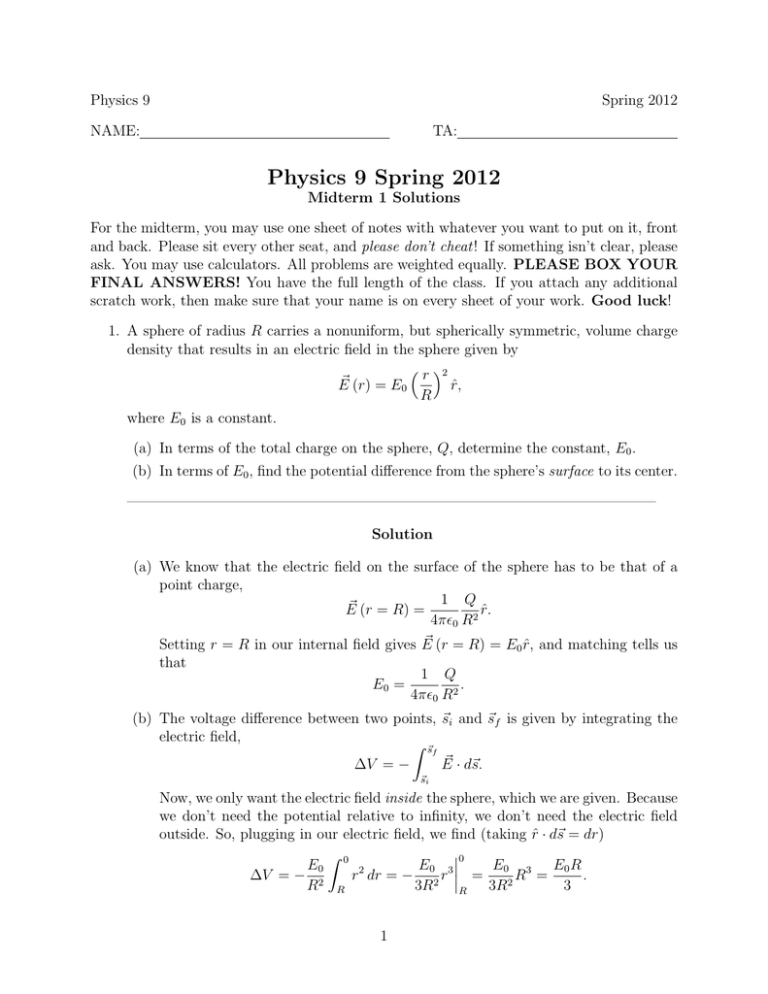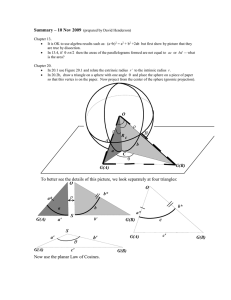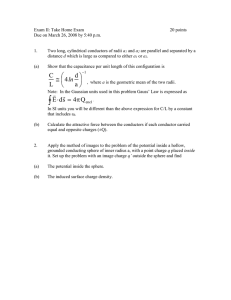Physics 9 Spring 2012
advertisement

Physics 9 Spring 2012 TA: NAME: Physics 9 Spring 2012 Midterm 1 Solutions For the midterm, you may use one sheet of notes with whatever you want to put on it, front and back. Please sit every other seat, and please don’t cheat! If something isn’t clear, please ask. You may use calculators. All problems are weighted equally. PLEASE BOX YOUR FINAL ANSWERS! You have the full length of the class. If you attach any additional scratch work, then make sure that your name is on every sheet of your work. Good luck! 1. A sphere of radius R carries a nonuniform, but spherically symmetric, volume charge density that results in an electric field in the sphere given by 2 ~ (r) = E0 r r̂, E R where E0 is a constant. (a) In terms of the total charge on the sphere, Q, determine the constant, E0 . (b) In terms of E0 , find the potential difference from the sphere’s surface to its center. ———————————————————————————————————— Solution (a) We know that the electric field on the surface of the sphere has to be that of a point charge, ~ (r = R) = 1 Q r̂. E 4π0 R2 ~ (r = R) = E0 r̂, and matching tells us Setting r = R in our internal field gives E that 1 Q E0 = . 4π0 R2 (b) The voltage difference between two points, ~si and ~sf is given by integrating the electric field, Z ~sf ~ · d~s. ∆V = − E ~si Now, we only want the electric field inside the sphere, which we are given. Because we don’t need the potential relative to infinity, we don’t need the electric field outside. So, plugging in our electric field, we find (taking r̂ · d~s = dr) 0 Z E0 0 2 E0 3 E0 3 E0 R r dr = − 2 r = ∆V = − 2 R = . R R 3R 3R2 3 R 1 2. Calculate the current through and power dissipated in each resistor in the circuit seen to the right. Enter your results in the table below with the given resistances. Resistor R1 = 2 Ω R2 = 4 Ω R3 = 4 Ω R4 = 4 Ω Current (A) 2 1 1 2 Power (W) 8 4 4 16 R 16 V R R R 1 2 4 ———————————————————————————————————— Solution In order to find the current through each resistor we need to determine the current coming from the battery. We begin by redrawing the circuit, combining the two resistors in parallel to an equivalent circuit. Recalling that 1 1 1 1 1 1 = + = + = , Reqv R2 R3 4 4 2 we see that the equivalent resistor is 1/ (1/2) = 2 Ω, as drawn in the diagram to the right. Now we simply have three resistors in series, for which the equivalent resistance can be found simply by adding the individual resistances, Reqv = 2 + 2 + 4 = 8 Ω, 2.0 Ω 16 V 2Ω 4.0 Ω 16 V 8Ω which gives us our equivalent circuit seen at right. Now, finding the P current produced by the battery is trivial using Kirchhoff’s loop law and Ohm’s law, i ∆Vi = E − IR = 0, such that I = E/R = 16/8 = 2 amps. This is also the current through R1 and R4 in the original circuit since these resistors are in series with the battery. From Kirchhoff’s junction rules, the 2 amp current is split evenly (for one amp, each) between resistors 2 and 3 since they both have the same resistance. The power in each resistor is just P = I 2 R, which gives P1 = (2)2 × 2 = 8 W, and P2 = P3 = (1)2 × (4) = 4 W, while P4 = (2)2 × 4 = 16 Watts. 2 3 3. An uncharged, infinitely long conducting cylinder of radius a is placed in an initially ~ = E0 î, such that the cylinder’s axis lies along the z axis. The uniform electric field E resulting electrostatic potential is V (x, y, z) = V0 for points inside the cylinder, and V (x, y, z) = V0 − E0 x + E 0 a2 x x2 + y 2 for points outside the cylinder, where V0 is the (constant) electrostatic potential on the ~ conductor. Use this expression to determine the resulting electric field, E. ———————————————————————————————————— Solution ~ = −∇V . The electric field can be found from the voltage by finding the gradient, E So, Ex = − ∂V ∂x h i a2 x ∂ = − ∂x V0 − E0 x + xE20+y 2 h 2 2 i 2 x +y −x(2x) = 0 + E0 − E0 a 2 2 2(x2+y2 ) −y = E0 + E0 a2 (xx2 +y . 2 )2 Next, Ey = − ∂V ∂y i h a2 x ∂ = − ∂y V0 − E0 x + xE20+y 2 2y = 0 + 0 + E0 a2 x (x2 +y 2 )2 = 2E0 a2 xy . (x2 +y 2 )2 Finally, the z-component is simplest of all, Ez = − ∂V = 0, ∂z since nothing depends on z. Thus, the electric field is 2 2 x − y 2E0 a2 xy 2 ~ E = E0 + E0 a î + ĵ. (x2 + y 2 )2 (x2 + y 2 )2 This electric field is made up of the original external electric field, E0 î, and the induced field, which is everything else ~ ind = E i E 0 a2 h 2 2 x − y î + 2xy ĵ . (x2 + y 2 )2 3 4. Consider a charged sphere of radius R, and total charge Q, but carrying a sphericallysymmetric charge density πr A ρ (r) = 2 cos , r 2R where A is a constant. (This isn’t a very realistic charge density, since it blows up at the center of the sphere, but it’s okay for this problem.) (a) Determine the constant A in terms of the total charge on the sphere, Q, and the radius of the sphere, R. (b) Write down (i.e., you don’t need to derive it) the electric field at a distance r from the center outside the sphere. (c) Determine the electric field at a distance r from the center inside the sphere. (d) Do your results from parts (b) and (c) match on the boundary, when r = R? Hint: Recall that, for a sphere, dV = 4πr2 dr. ———————————————————————————————————— Solution (a) The total charge may be found by integrating the charge density over the total R volume of the sphere, Q = ρ dV . So, Z Z R πr 2R 1 2 r cos dr = 4πA × = 8RA, Q = ρ dV = 4πA 2 2R π 0 r from which we find that A = Q . 8R (b) Outside the sphere the field is simply that of a point charge, Eout = Q , 4π0 r2 which can be easily found using Gauss’s law. (c) To determine the field inside the sphere we use Gauss’s law, I ~ · dA ~ = Qencl . E 0 r R The first step is to choose a Gaussian surface over which to integrate. Based on the symmetry of the charge distribution we choose a spherical surface of radius r ≤ R. As we’ve seen many times, along this surface the electric field is constant and points along the direction of the normal to the surface. H H ~ · dA ~ = EdA cos θ = Thus, the left-hand side of Gauss’s law becomes E H E dA = EA = E (4πr2 ). To determine the enclosed charge we again integrate the charge density, only this time out to the same radius r ≤ R. Then Z Z r πr πr πr 1 2 r cos dr = 8RA sin = Q sin , Qencl = ρ dV = 4πA 2 2R 2R 2R 0 r 4 after plugging in for A. Notice that, if r = 0 we get Qencl = 0, while if r = R we have Qencl = Q, as expected. Thus, Gauss’s law gives πr πr Q Q E 4πr2 = sin ⇒ Ein = . sin 0 2R 4π0 r2 2R (d) When r = R the electric field outside then Eout = while Q Ein = sin 4π0 R2 Q , 4π0 R2 πR 2R = Q , 4π0 R2 and so the fields agree on the boundary, as we expected. 5 Extra Credit Question!! The following is worth 10 extra credit points! where and σ are constants, and r is the distance between the molecules. The potential energy is plotted in the figure to the right. The vertical axis is in units of , while the horizontal axis is in units of σ. Energy The potential energy between a pair of neutral atoms or molecules is very well-approximated by the Lennard-Jones Potential, given by the expression σ 12 σ 6 , P E(r) = 4 − r r Molcular Bond Energy 8 7 6 5 4 3 2 1 0 0.75 -1 1 1.25 1.5 1.75 2 2.25 2.5 2.75 3 -2 -3 -4 Distance (a) Why does the potential energy approach zero as the distance gets bigger? (b) At what separation distance, in terms of σ and , is the potential energy zero? (c) At approximately what distance is the system in equilibrium? What is the potential energy at that distance? (Express your answers in terms of σ and .) (d) How much energy would you need to add to the system at equilibrium in order to break the molecular bonds holding it together? Why? (e) How much energy is released in the breaking of those molecular bonds? Why? Note - no calculation is needed to answer these problems! ———————————————————————————————————— Solution (a) As the two molecules get further apart, the attractive force between them gets weaker and weaker. When the are very far apart, they hardly interact at all they are basically free molecules. The potential energy of a free particle is zero, since potential energy depends on the interaction between multiple particles. (b) We can just read the value off from the graph. We see that the potential energy crosses the x axis when x = 1, which means that r = σ. We can see this from the equation, too: setting r = σ gives P E(σ) = 0. 6 3.25 (c) The system is in equilibrium when the net force on it is zero. Since the force is the slope of the potential energy graph, this happens when the slope is zero. The potential energy graph has zero slope when it’s at it’s minimum point. Checking the graph, we see that this happens right around x ≈ 1.15, or r ≈ 1.15σ. We could d (P E(r)) = 0, which gives r = 21/6 σ ≈ 1.12σ, check the exact answer by finding dr and so we were close on our guess. The energy at this distance can just be read off the graph, giving y = −3, or P E = −3. (d) In order to break the molecular bonds apart, we’d need to raise the energy to zero. At equilibrium the energy is P E = −3, and so we’d need to add +3 units of energy. (e) There is no energy released in breaking these molecular bonds - we had to add the energy to break these bonds. Energy is never released in the breaking of bonds! One can obtain energy by breaking a less stable bond, then forming a more stable bond. The more stable bond has a more negative potential energy (a deeper potential “well”). The difference in energy between the initial and final states is released to the environment. This is where the energy comes from in the ATP reactions, and not by releasing energy from the breaking of bonds! 7 Some Possibly Useful Information Some Useful Constants. Coulomb’s Law constant k ≡ 1 4π0 = 8.99 × 109 N m2 . C2 The magnetic permeability constant µ0 = 4π × 10−7 N . A2 Speed of Light c = 2.99 × 108 m/s. Newton’s Gravitational Constant G = 6.672 × 10−11 N m2 . kg 2 The charge on the proton e = 1.602 × 10−19 C The mass of the electron, me = 9.11 × 10−31 kg. The mass of the proton, mp = 1.673 × 10−27 kg. 1 eV = 1.602 × 10−19 Joules ⇒ 1 MeV = 106 eV . 1 Å = 10−10 meters. Planck’s constant, h = 6.63 × 10−34 J s = 4.14 × 10−15 eV s. The reduced Planck’s constant, ~ ≡ h 2π = 1.05 × 10−34 J s = 6.58 × 10−16 eV s. Some Useful Mathematical Ideas. ( n+1 x R n n 6= −1, x dx = n+1 ln (x) n = −1. √ R dx √ = ln x + a2 + x2 . a2 +x2 R √ x dx a2 +x2 = √ a2 + x 2 . Other Useful Stuff. The force on an object moving in a circle is F = mv 2 . r Hooke’s Law says that FS = −kx. Kinetmatic equations x(t) = x0 + v0x t + 21 ax t2 , y(t) = y0 + v0y t + 12 ay t2 . The binomial expansion, (1 + x)n ≈ 1 + nx, if x 1. 8




